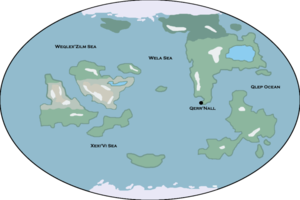User:Caelphon
| Dionae Lore Pages | ||
|---|---|---|
| Species | Dionae · Dionae Forms · Dionae Mindtypes · Dionae Biology · Dionae Out-Of-Character | |
| Locations, Planets & Systems | Covenant of Xrim · Hieroaetheria · Rueltab · Primitive Sirens of Mictlan · Eternal Gardens | |
| Conglomerates & Factions | Dionae in the Federation · Dionae in the Hegemony · Vaurcae & Dionae · The Narrows · Minor Dionae Factions | |
| Culture, History & Society | Dionae Culture · Notable Dionae · Voidic Proto-Culture · Dionae Space Capabilities · Dionae History · Dionae Integration · The Eternal | |
| Lore Arcs | Omnivirate's Providence | |
Epsilon Ursae Minoris, the Planet of Eden
The first planet discovered to have a sizeable community of Dionae - independently growing around a singular beacon. Discovered in the late 2420s by Captain Weirun Tup, the world was initially believed to contain an anomaly that produced electromagnetic interference but instead upon further investigation the Captain was welcomed by a Colony of the secluded community. After a great deal of time, Epsilon Ursae Minoris eventually saw the initial Skrell settlement of Qerr'Naal grow and prosper into a megapolis.
In recent times Epsilon Ursae Minoris has undergone a 'revival' with Skrell, and Dionae, architects carefully planning around the agreement of the singular settlement - with skyrises that reach high into the atmosphere, and deep beneath the crust of the planet. Whilst most of the industry revolves around the agricultural sector, the Federation continually has tried to push the boundaries of the agreement, allowing for more and more industries to crop up across Qerr'Naal.
History
The vast majority of the History on Epsilon Ursae Minoris is unknown, however, each day more and more is uncovered. Whilst the discovery of the planet in the 2420s rocked the scientific community across the Orion Spur, it took incredibly long for any official research to be conducted, specifically into the historical records of the planet. Sometime after the Captain joined the Dionae, the planet became the hub for those wishing to do the same - eventually birthing a religion regarded as 'Dienabi'. The rest of the history of the planet can be found here.
Environment
Epsilon Ursae Minoris' relatively young lifespan has allowed for the formation of a planet-wide ocean, with minor continents splitting the depths - with the lands being relatively flat besides that of the few mountains that dot the planet. A continental climate is the most common climate across the planet - with seasons occurring, typically long, hot summers and cold, dry winters - which has allowed for world encased in natural beauty all year round, with various ranges of different hues that paint the landscape into magnificent works of art.
Rotation & Orbit
Epsilon Ursae Minoris takes approximately 37.1 hours to rotate on its own axis, with the larger part of the day taking up most of the planet's rotation, combined with the binary-pairing it orbits, has allowed for an extremely illuminated landscape that remains in darkness for only a trivial period - with the planet only completing an orbit every 482 days, the planet basks in the starlight for innumerable periods.








